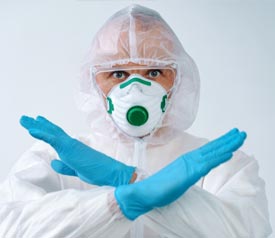
Cross-contamination is a serious problem in the medical industry. This issue arises when patients obtain an infection from an open wound. According to a 2019 study, the rate of surgical site infections (SSIs) can be as high as 20%. Rates across all inpatient procedures range from 2-4% in total.
In this article, we’ll discuss cross-contamination, why it’s important to prevent it as often as possible, and tips on how to limit the chances of cross-contamination from occurring.
What Is Cross-Contamination
An instance of cross-contamination occurs when a patient is infected after receiving care at a medical facility. From IV wounds to surgery wounds and everything in between, there are many opportunities for bacteria, viruses, and other contaminants to enter a patient’s body through a fresh wound. If precautions aren’t taken (and even if they are), a wound can become infected and lead to mild to severe health complications.
Medical facilities see a lot of traffic on a daily basis and many patients may enter with serious illnesses. Couple this with rushed doctors and nurses who may not sanitize tools properly or wash their hands thoroughly and there are many opportunities for cross-contamination.
Proper precautions can be taken to lower the chances of cross-contamination after a medical procedure. With proper cleaning and sanitizing, patients can be much safer from illness. Proper wound care is also essential, from using high-grade gauze to securing wound covers with waterproof, skin-sensitive tapes like Hy-Tape.
Why Avoiding Cross-Contamination Is Vital
Keeping patients as safe as possible from cross-contamination and infection is essential to their healing. When the body goes through the stress of surgery or even the use of an IV, it needs as little stress as possible to heal. If a patient comes down with a virus or bacterial infection during recovery, their body can fail to heal correctly.
Cross-contamination can also add to the physical toll a surgery can take on a person. More discomfort and slower healing times are also common problems for those who become infected while recovering from a major procedure.
For older patients or those with weaker immune systems, cross-contamination can raise the chances of mortality. Those who are older or immunocompromised need as much of their health as possible to recover from their procedure, and an infection can be too much for the body.
Sources of Cross-Contamination
A lot of problems can lead to cross-contamination at a medical facility. Just a few factors that raise the chances of cross-contamination include:
- Unclean Hands – Medical professionals taking care of patients must wash their hands thoroughly before performing any work. If they don’t clean up properly before administering any care, they may put the patient at risk of infection.
- Unclean Skin – When medical professionals pierce the skin of a patient in any way, from inserting an IV to performing surgery, the skin must be sanitized beforehand. Without proper sanitization of the skin, bacteria or viruses could enter the bloodstream.
- Prolonged Inpatient Care – While inpatient care may be vital to the health of a patient, continued use of the same IV, catheter, or other medical devices can lead to infections.
- Unsterilized Medical Equipment – When medical instruments aren’t properly cleaned before a procedure, they could have bacteria and viruses could live on their surface. These can enter the body easily during surgery and cause issues right away.
Fortunately, most of these situations are preventable, although there are no guarantees that proper sterilization and careful consideration will eliminate all chances of cross-contamination.
Prevention of Cross-Contamination
Preventing cross-contamination can be done with a few easy practices. Medical professionals and caregivers should consider the following preventive measures:
- Use Personal Protective Equipment – Masks and gloves are essential for helping prevent cross-contamination issues. Swapping these items for fresh ones between treating patients or even after a quick bathroom break can make a major difference.
- Perform Basic Hygiene – Proper hygiene goes a long way in helping to prevent cross-contamination. Alcohol-based antimicrobial gels can provide a thorough cleaning to the hands and should be used before and after any procedure or wound dressing activities.
- Perform Equipment Disinfection – Disinfecting all equipment, tools, and materials that come in contact with a patient can help lower the chances of complications. From IV needles to bedding, everything should be disinfected before use.
- Use Single-Use Products – Utilizing single-use products can help ensure cleanliness when dealing with an open wound. Lack of exposure to other people and patients is always helpful.
Prevention is always preferred over treatment when it comes to cross-contamination. These simple steps can make patient care much easier for medical professionals as well as patients.
Hy-Tape Single-Use Rolls Can Be Beneficial in the Fight Against Cross-Contamination
Single-use items of every kind are the best option for avoiding health complications. Hy-Tape’s single-use tape rolls offer the tape that’s needed in a small, one-time-use package.
Hy-Tape is designed to be sensitive to the skin while also holding tight. The tape is flexible enough to shift carefully with a patient’s movements and it’s waterproof to keep out perspiration, humidity, and skin oils. When applied to dry, clean skin, Hy-Tape can keep wound dressings, IVs, and other essentials in place without a problem.
The single-use roll offers medical professionals to use a single roll for a single patient, helping avoid cross-contamination . Our tapes come in 1.5-yard lengths and ½” width or 1” width styles.
Avoiding cross-contamination is easy when the right precautions are taken. With proper cleaning, use of PPP, and Hy-Tape single-use rolls, you can nearly eliminate the chances of cross-contamination.

